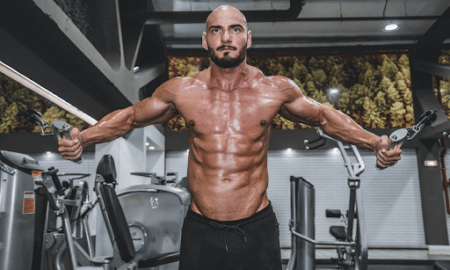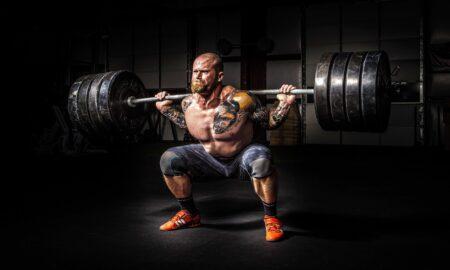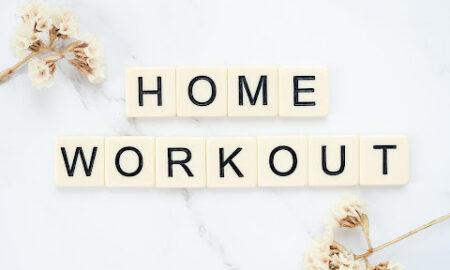Q: What’s your take on using the preexhaustion method that Arthur Jones touted so much?
A: It’s a valuable training method. With preexhaustion you fatigue a muscle with a single-joint exercise and then exhaust it further with a multijoint exercise that involves the same muscle. For example, you could superset lateral raises with behind-the-neck presses or biceps curls followed by chinups.
Jones liked the method so much that he designed several machines that combined two exercises into one unit to minimize the rest time between sets. One such unit was a leg extension machine that was combined with a leg press.
Jones used preexhaustion when he trained Casey Viator in 1970. Viator weighed 198 pounds at the time. In 10 months he added 20 pounds of solid muscle, and he won the ’71 AAU Mr. America—as a teenager. In one workout Viator reportedly did 13 full squats with 502 pounds after preexhausting his legs with 20 reps on the leg press with 750 pounds and 20 on the leg extension with 225 pounds.
Although preexhaustion is a popular training method, another method that can be useful in your training toolbox is postexhaustion. That involves supersetting a compound movement with an isolation exercise that taps into the same motor unit pool as the muscle you want to focus on.
The secret to success is selecting great exercises, so you wouldn’t superset lunges with leg curls. A list of great postexhaustion supersets would include close-grip chinups with low-incline dumbbell curls and close semisupinated chinups with seated dumbbell hammer curls. Here’s one of my favorite postexhaustion workouts for the arms:
A-1) Close-grip chins, 4 x 4-6, 4/0/1/0 tempo
Rest 10 seconds
A-2) Low-incline dumbbell curls, 4 x 6-8, 5/0/1/0 tempo
Rest 3 minutes, then repeat
B-1) Parallel-bar dips, 4 x 4-6, 3/2/1/0 tempo
Rest 10 seconds
B-2) Overhead rope extensions, 4 x 8-10, 3/1/1/0 tempo
Rest 3 minutes, then repeat
Give it a shot. Postexhaustion training is a great way to overcome slumps in muscle growth.
Q: Should I buy a pair of weightlifting shoes? I’m a bodybuilder, and I’ve heard they’re useful for squatting.
A: The first reason to purchase a pair of weightlifting shoes is that they provide a stable platform for squatting, and their stability is often increased with a strap that crosses the top of the foot. Running shoes—or any shoes with a large amount of shock absorption—aren’t safe for squats because they create instability.
Lifting shoes have a raised heel that enables you to incline your shins more forward. That helps compensate for a lack of flexibility in the ankles and lower-leg muscles that could cause you to lean forward too much. Leaning forward increases the compression forces on the spine, and with front squats too much lean causes the bar to fall off your shoulders.
Because I recommend squatting all the way down with your trunk upright, I consider the weightlifting shoe an extremely wise investment. As you use them only for lifting—although they can also serve as bowling shoes in an emergency—one pair can easily last a decade.
Also regarding squats, the raised heel of the lifting shoe often helps improve squatting technique by helping to correct foot pronation. That’s one reason, along with muscle imbalances, that your knees may buckle excessively during the exercise.
Some bodybuilders try to compromise by using boots, but that’s a mistake. The shoes should be low cut, and a higher-top shoe or boot doesn’t let the ankle joint flex. Also, a heel that’s too high could place excessive stress on the knees.
Q: I’m 24 years old and considering entering my first figure competition. The problem is, I have a flat butt, and it seems to get worse when I diet down. Any exercise suggestions for building a rounder, fuller set of glutes?
A: Follow whatever exercise program Kim Kardasian is using. Seriously, here is a great tri-set that will add some muscle to your glutes:
A-1) Full squats x 6 reps
Rest 10 seconds
A-2) Lunges x 12 reps per leg
Rest 10 seconds (use the time to retrieve your spleen from under the seated calf machine)
A-3) Dumbbell deadlifts x 25 reps
Rest 120 seconds, then repeat twice more
Because you should rest for only 10 seconds between the first two exercises, it’s important to set up the weights you’ll be using for the next two moves before you begin, and change the weights for the next tri-set after the dumbbell deadlifts.
Q: Is there any easy method of determining whether I’m overtrained and need to back off my workouts or take a day off?
A: Here’s a simple way to tell. Record your bodyweight every morning when you wake up, after using the restroom. If your diet hasn’t really changed yet you suddenly see a 3.5 percent drop in bodyweight, then you’re probably starting to overtrain—which is another way of saying you’re under-recovered.
The change in bodyweight is caused by a loss of muscle. So if you’re an experienced athlete and typically weigh 200 pounds, then suddenly drop to 193 almost overnight without trying to, you’re overtrained. The solution is to back off on the number of total sets you do, but not the intensity.
Q: What’s the proper way to perform Smith-machine squats to minimize the stress on my knees? Should I keep my heels under the bar, as in a regular squat, or should I position them forward?
A: It’s less harmful to your knees if you keep your heels under the bar, but when it comes to injury, it’s a matter of repeated exposure. One three-week cycle per year of Smith-machine squats with your heels under the bar would probably not tear your patella, but I wouldn’t make the exercise a staple.
For athletes, I don’t like the Smith machine because the strength developed is not as transferable, so I don’t prescribe it. It also can be stressful on the spine. I say that because the barbell travels in a fixed movement pattern, which does not allow for anatomical differences that you can adjust for in a conventional squat, where the barbell can rotate.
Also, when you use the exercise, it’s important to set the safety stoppers at the appropriate height. I know of five cases in which individuals became paraplegics -and one person died from improper use of the Smith machine.
Q: For arm development, is it better to perform exercises slow or fast?
A: Research has found that certain muscles respond better to high-velocity exercises due to their fiber makeup, and that’s one reason you can’t stick dogmatically with one training theory if you expect to achieve maximum results quickly. For example, take the biceps brachii.
The biceps brachii has two bundles of muscles that insert at the same point at the elbow joint. We call those bundles the short head and the long head, and their anatomy enables several functions: flexing your elbow, supinating your forearm—that is, turning the palms upward—and helping with several shoulder movements in addition to lending to shoulder stability.
Studies conducted in Japan found that the biceps brachii responds bests to high-speed, or high-velocity, training. Two such exercises for that muscle group are the seated incline curl and the standing barbell curl—you’d curl the weights explosively and then lower them under control.




















You must be logged in to post a comment Login